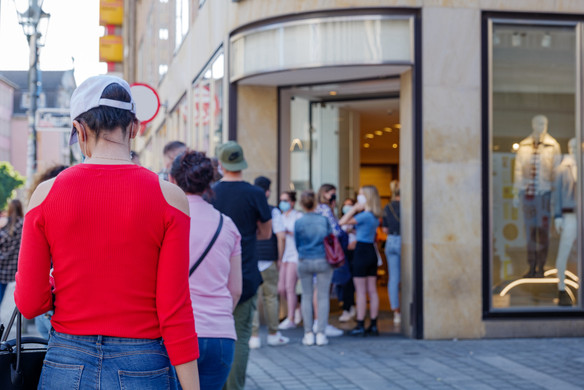Table of contents
As retailers transition to post-COVID business in the United States, the new normal of digital meets physical is set to evolve the shopping experience — all while the country is on the cusp of kicking off a summer like no other. This season is a huge opportunity for retailers to capitalize on the return to socialization and office work, making up for lost time and the havoc wreaked on retail operations last year.
Has brick-and-mortar retail changed forever? Yes. Is brick-and-mortar retail finished? Not by a long shot.
Rather, the role of the physical store is changing. There are new opportunities for brands and retailers with physical spaces, inspired by digital commerce. And on the flip side, some of the enhancements made to digital shopping over the past year — virtual styling and appointments, live help, events, and more — bridge the physical-digital divide and likely are here to stay.
Other hot topics for consideration this summer? Customer engagement across channels, resale’s role in reaching new generations, the future of fashion NFTs, and return-to-office fashion trends.
The new role of the physical store
Digital shopping has transformed brick and mortar. There’s a new expectation that a brand’s store has appropriate consistency with its digital experience, from pricing and associate knowledge to product experiences. The physical experience can’t become lesser in any of these ways.
Juxtapose these expectations with massive consumer enthusiasm to return to in-store shopping. There’s a newfound novelty to shopping in-person, and brands must over deliver on an in-store experience not only on par with digital, but better. And the measurement of stores and the incentives for the people who work in them need to reflect digitally completed transactions.
But physical spaces are unique in their ability to host creative activations that build memorable in-store experiences. For example, for Mental Health Awareness Month, Saks Fifth Avenue hosted an interactive experience in its flagship New York City store called the “Intention Garden.” Shoppers could write mental health goals or intentions on a wooden stake and plant them in Saks’ on-site garden.
Notably, Saks also created and sent an at-home version of the activation to influencers. “Let It Go and Let It Grow” included a wildflower plant, planting tools, and ideas on creating mental health intentions at home.
Retention and bridging the digital divide
All this talk of going out and leaving the house means consumers may not be spending as much time at home and in front of screens as they had been since March 2020. Once again, brands will need to reconsider where their target audience is and how to show up in an engaging way this summer. Beyond physical retail, the most relevant and notable ways to connect could be digital out-of-home (DOOH), billboards, or events, to name a few.
The core tenets of customer retention, from valuing loyal customers to building better experiences based on user data and feedback, have always been paramount in retail and became even more so as the industry was put under immense pressure during the pandemic.
As businesses reopen, brands that gained new customers online now have an opportunity to introduce those customers to their physical stores. It’s an exciting new point of connection and one that should be leveraged.
Recommerce revival
Consumers across generations have powered a surge in resale, but Gen Z has led the charge. Brands are seeing consumers care about sustainability; they want to invest in fashion items that won’t go to waste in the long term.
Look at Etsy’s acquisition of resale site Depop, aimed at capturing more of Gen Z and a portion of the growing secondhand market. The Etsy shopper may not be who first comes to mind when thinking about resale, but the acquisition will boost Etsy’s customer base, reaching new and younger audiences via the growing consignment market.
Brands that aren’t in the traditional resale space should still think end to end about how to work with consumers to give products second lives, whether it’s through partnerships with resale brands or creating their own consignment, recycling, or repair programs.
Fashion and NFTs, going beyond the hype
Over the past year, consumers have learned we need a lot less in terms of material goods than previously thought. Even some fashion-lovers are questioning whether it really makes sense to fill closets with more clothes, shoes, and accessories. At the same time, despite the return to in-person activities, people continue to care more than ever about their digital presence.
If one loves fashion and wants to express that, fashion NFTs may be the answer. In an industry all about collection, fashion NFTs make a lot of sense. For brands, as fashion NFTs evolve from collectables to offer more utility, it’s an entirely new way to approach products, technology, and connections with younger audiences on social platforms and beyond.
Return to office
Remember the seven-days-a-week wardrobe? The day-to-night looks? The promises of versatility that so many apparel retailers professed?
These marketing strategies, once popular among retailers targeting professionals with a business casual closet, catered to consumers who didn’t want to make a distinction between occasions. For many nonessential workers who are wrapping up more than a year of staying home and rotating among a smaller stable of go-to pieces throughout the day and week, there’s now pent-up demand to dress differently depending on what one is doing.
Specifically, as offices reopen and move to a hybrid location model, going into the office will become more of an occasion — and an opportunity to dress to impress.
Consumers are back. They’re ready to shop in stores for items they haven’t needed recently, but also to tap into the new digital behaviors learned over the course of the pandemic. There’s so much opportunity for retailers this summer, from fan-favorite small, local businesses to DTC favorites expanding their footprints. Social activities, summer travel, and various levels of returning to the office reflect that people are hungry to resume life as we knew it.
While shopping habits and behaviors are forever changed, new opportunities to delight shoppers abound.
![]()











